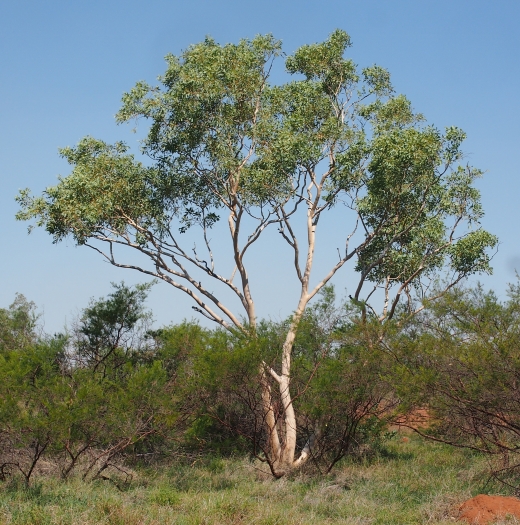Smooth-Barked Coolibah
(Eucalyptus victrix)
Smooth-Barked Coolibah (Eucalyptus victrix)
/
/

Mark Marathon
CC BY-SA 3.0
Image By:
Mark Marathon
Recorded By:
Copyright:
CC BY-SA 3.0
Copyright Notice:
Photo by: Mark Marathon | License Type: CC BY-SA 3.0 | License URL: https://creativecommons.org/licenses/by-sa/3.0 | Uploader: Mark Marathon | Publisher: Wikimedia Commons | Title: Eucalyptus_victrix.jpg | Notes: {{Information| |Description=Eucommia ulmoides: Flowering shoot |Source=Own photo, taken Botanical Garden, Jutland. |Date=30.4.2007 |Author=[[User:Sten|Sten Porse]] |Permission={{self2|GFDL|cc-by-sa-2.5,2.0,1.0}} |other_versions= }} [[Category:Eu |









Estimated Native Range
Summary
Eucalyptus victrix, commonly known as the smooth-barked coolibah, western coolibah, or little ghost gum, is a small to medium-sized deciduous tree endemic to the arid and semi-arid regions of Australia. It is often found in open woodlands and on floodplains, where it plays a crucial role in the ecology by providing habitat and food for local wildlife. This species typically grows to a height of 1–12 m (3 ft 3 in – 39 ft 4 in) but can reach up to 22 m (72 ft) in ideal conditions. It has a striking appearance with smooth, white to cream-colored bark that sheds in flakes, lance-shaped to curved adult leaves, and creamy white flowers that are borne in groups of seven. The flowering season extends from November to March, and the flowers are followed by the development of woody, conical fruit capsules.
The smooth-barked coolibah is valued for its ornamental features, including its attractive bark and canopy, which make it suitable for use as a garden ornamental. It is also appreciated for its drought and wind tolerance, making it a good choice for xeriscaping and for planting in challenging environments. In cultivation, it requires full sun exposure and thrives in most soil types, provided they are well-drained. While not commonly cultivated, it can be grown from seed and is generally low-maintenance, rarely needing pruning except for shaping or form. It is resistant to most diseases and pests, adding to its appeal for gardeners.CC BY-SA 4.0
The smooth-barked coolibah is valued for its ornamental features, including its attractive bark and canopy, which make it suitable for use as a garden ornamental. It is also appreciated for its drought and wind tolerance, making it a good choice for xeriscaping and for planting in challenging environments. In cultivation, it requires full sun exposure and thrives in most soil types, provided they are well-drained. While not commonly cultivated, it can be grown from seed and is generally low-maintenance, rarely needing pruning except for shaping or form. It is resistant to most diseases and pests, adding to its appeal for gardeners.CC BY-SA 4.0
Plant Description
- Plant Type: Tree
- Height: 20-30 feet
- Width: 8-12 feet
- Growth Rate: Moderate
- Flower Color: Cream, White
- Flowering Season: Winter, Spring
- Leaf Retention: Evergreen
Growth Requirements
- Sun: Full Sun
- Water: Low, Very Low
- Drainage: Medium, Fast
Common Uses
Bee Garden, Bird Garden, Butterfly Garden, Drought Tolerant, Fragrant, Hummingbird Garden, Low Maintenance, Street Planting
Natural Habitat
endemic to the arid and semi-arid regions of Australia
Other Names
Common Names: Smooth-Barked Coolibah, Western Coolibah
Scientific Names: , Eucalyptus victrix,
GBIF Accepted Name: Eucalyptus victrix L.A.S.Johnson & K.D.Hill